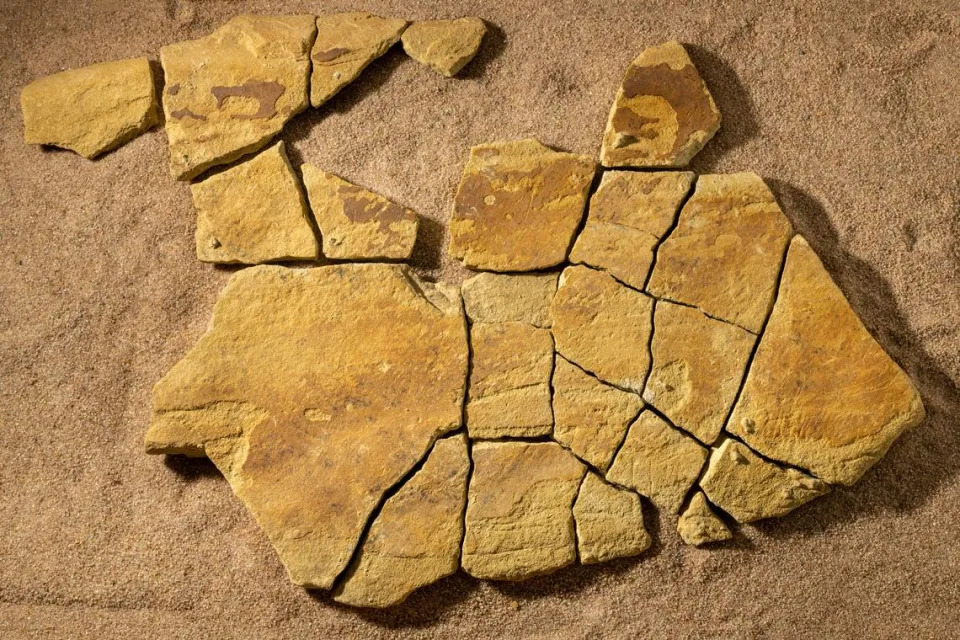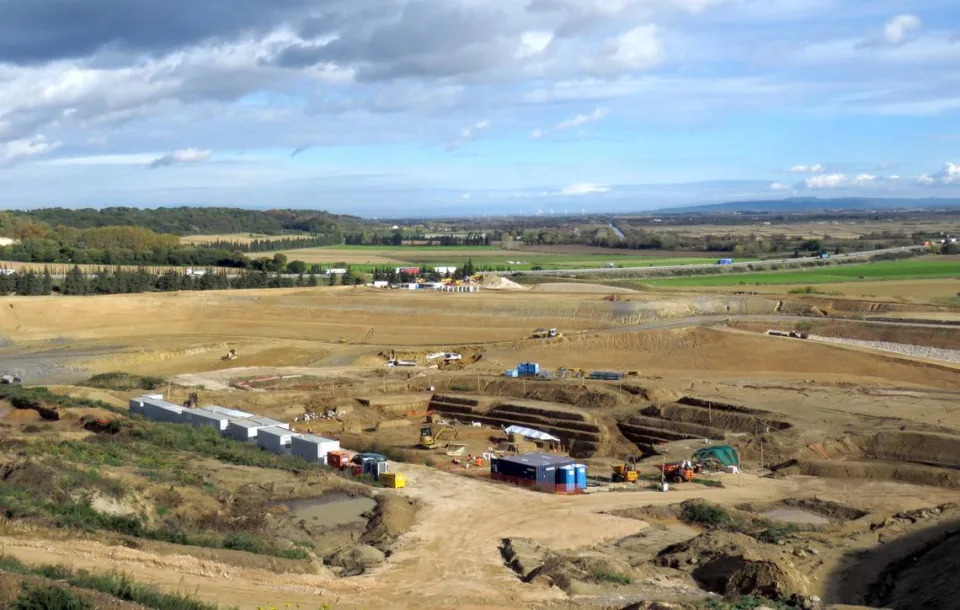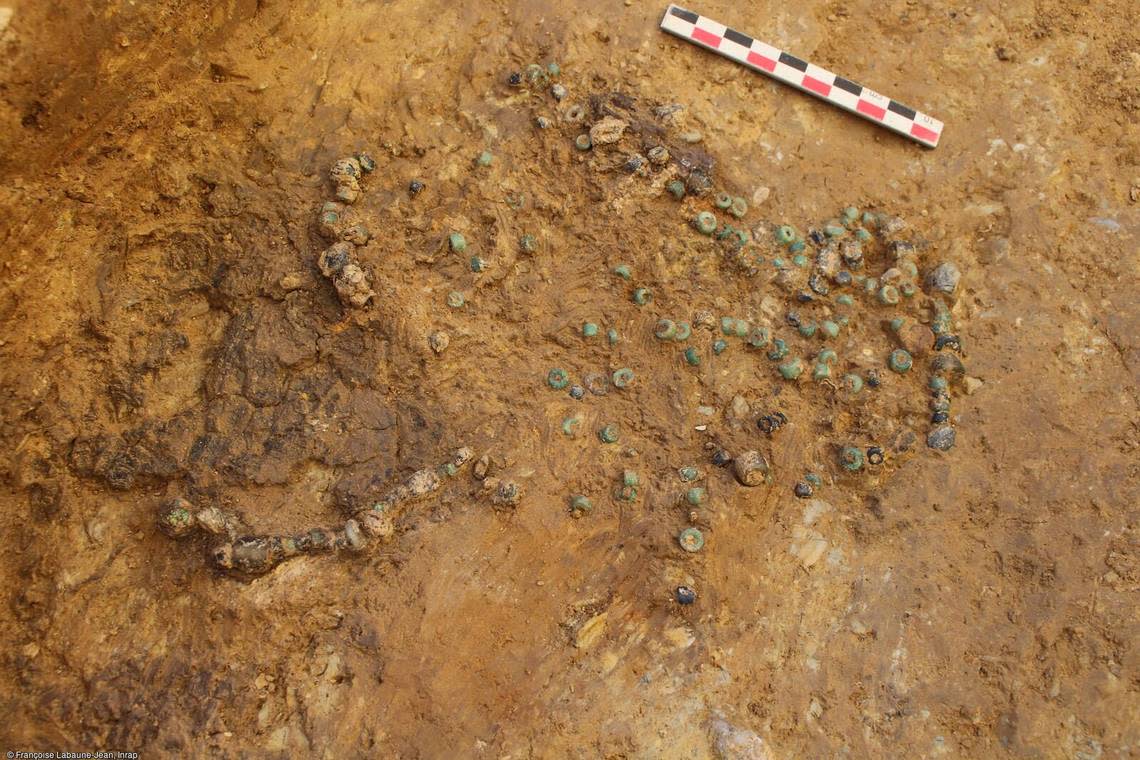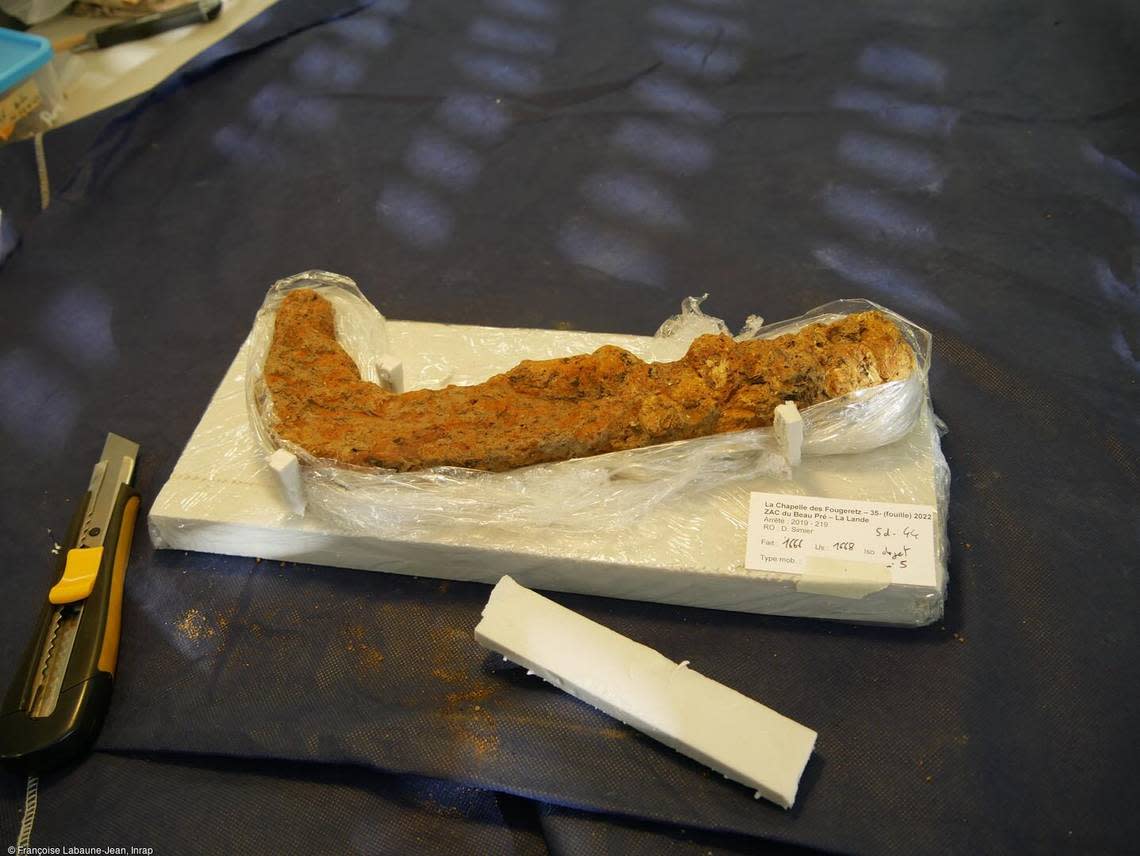Aspen Pflughoeft
Thu, April 6, 2023
At first glance, these yellow-brown stones don’t look very exciting. They’re not made out of some hard-to-find material. They’re not decorated with faded but preserved pastel paints. They look like, well, rocks.
Yet French archaeologists are calling these rocks — and their engravings — “exceptional.” Why? You’ll see after a closer look.
Archaeologists were excavating a site near Bellegarde, France, and uncovered four pieces of art from the Paleolithic era, the French National Institute for Preventive Archaeological Research said in a March 31 news release also shared with McClatchy News in English. The engravings were left by the Magdalenians, an ancient culture that emerged about 20,000 B.C.

The Bellegarde archaeological site.
Two of these carvings were 22,000 years old and showed horse profiles with “many precise anatomical details,” archaeologists said.
One carving showed the left-hand side of a single horse’s head, photos show. The animal’s nose reaches the far left edge of the stone, its ears almost touch the top, and its neck — topped with a flowing mane — extends off the right-hand side.

Highlights show the shape of the horse carving.
A second carving showed a trio of horses, also facing the left side, photos show. The horses are grouped closely together, depicted by their disconnected, almost floating, heads. The animal on the farthest left has a distinctly carved eye. The center horse is defined by its jawbone. The right-hand horse appears to be looking partially downward, its neck extending off the rock.

Highlights show the trio of horses.
Archaeologists uncovered another Magdalenian engraving from 18,000 years ago, the release said. This carving represents a female and shows an exaggerated vulva framed by legs. Photos show the design.
Experts emphasized the significance of this “exceptional” design, which has been found in “only one other specimen” of Magdalenian art, the release said.

The stone with a carving of a vulva.

Highlights show the design of the vulva carving.
The fourth ancient artwork archaeologists unearthed was the most puzzling, the release said. This piece was a fragmented stone slab about 19 inches long. It probably sat upright but was found broken on the floor of a dwelling among pieces of knapped flint, researchers said.
The fractured slab has many small incisions on it, but archaeologists could not figure out what these carvings meant, the release said. Photos show the fractured piece and the thin carvings decorating it.

The fragmented slab with thin incisions on it.

A close-up of some of the incisions on the fragmented slap.
Ancient art thrived among the Magdelinians. They lived “semisettled” lives and had “abundant food” allowing them the “leisure time” for creative and decorative pursuits, according to Britannica.
Other fragments of Magdelinian culture were also uncovered at the Bellegarde site, the release said. Archaeologists found many flint tools and weapons, reindeer bones and seashells that were used as beads, worn as adornments or attached to clothing. Photos show these ancient relics.

Some of the small blades found at the site.

A shell with signs of use as an adornment.

Another seashell with signs of use.
The archaeological site was found during the extension of a nearby landfill waste site, the release said. Subsequent excavations uncovered evidence that the site had been routinely, but not continuously, occupied since around 20,000 B.C., archaeologists said.

An archaeologist working at the Bellegarde site.
In total, archaeologists have found about 1,000 structures from a variety of periods and peoples. The structures included dwellings, storage spaces, craft workshops and agricultural buildings. Burials were also found at the site.

The site seen from afar.
Bellegarde is near the coast of the Mediterranean Sea and about 415 miles southeast of Paris.
Google Translate was used to translate the release from the French National Institute for Preventive Archaeological Research (INRAP).
2,000-year-old Roman sanctuary — and nearby burial ground — uncovered in France
ASPEN PFLUGHOEFT
Updated April 5, 2023
Empty tombs where skeletons had long since dissolved. A ditch where devoted offerings deteriorated. Traces of the Roman empire’s rule over western France echoing through the ages.
These traces of faded glory reemerged as archaeologists excavated an area of La Chapelle-des-Fougeretz, the French National Institute for Preventive Archaeological Research said in an April 4 news release.
La Chapelle-des-Fougeretz is a small city near Rennes and about 210 miles southwest of Paris. Rennes was established by the Roman empire around the end of the first century B.C., French officials reported in an archaeological atlas for the area.
Archaeologists found evidence of an important Roman occupation site at La Chapelle-des-Fougeretz, the release said. The ruins included a sanctuary, thermal bathhouse and burial ground.
The roughly 2,000-year-old sanctuary was dedicated to Mars, the Roman god of war, and built at the start of the Roman period, experts said. A statue of Mars and numerous weapons, such as swords and spearheads, were unearthed at the sanctuary. The weapons were likely left as offerings by devoted soldiers.

Archaeologists photographing and excavating a ditch at the sanctuary.
The nearby thermal bathhouse was a wooden, public building, archaeologists said. Everyday objects, such as pottery, were buried there.
A short distance away, archaeologists located a burial ground, or necropolis, a relatively unexpected find, the release said. The burial ground had 40 tombs. Photos show a few of these long, rectangular graves.

Two tombs found at the burial ground.
The necropolis was about 1,500 years old and used during the third and fourth centuries, experts said. By the fourth century, the entire site was abandoned.
No skeletons were found at the necropolis, archaeologists said. The bones had dissolved in the acidic soil, but traces of the occupants lingered in the form of grave goods.
The studded soles of a pair of shoes were unearthed in one tomb, experts said and photos show. Another person was buried with glass and ceramic vases. Someone else’s tomb had rich items, including silver bracelets, pins and belt buckles. In another grave, a dagger and parts of a horse harness were unearthed.

The soles of a pair of studded shoes left in a tomb.

Bracelets and beads unearthed from a tomb.

A pearl necklace buried in one of the tombs.
After excavating the site, archaeologists did an inventory of their finds and took the items to a laboratory for further study, the release said. All told, they found seven pieces of terracotta architectural elements, 35 pieces of pottery, 12 iron swords, 4 billhooks, a sickle and over 700 other artifacts.

One of the swords found at the site.

A sickle unearthed at the site.
About half of the ancient weapons were found at a ditch near the sanctuary, and the other half were found at the burial grounds.
The metal finds will require special treatment for preservation, the study said. Research on the artifacts is ongoing.
Google Translate was used to translate the news release and archaeological atlas from the French National Institute for Preventive Archaeological Research (INRAP).
ASPEN PFLUGHOEFT
Updated April 5, 2023
Empty tombs where skeletons had long since dissolved. A ditch where devoted offerings deteriorated. Traces of the Roman empire’s rule over western France echoing through the ages.
These traces of faded glory reemerged as archaeologists excavated an area of La Chapelle-des-Fougeretz, the French National Institute for Preventive Archaeological Research said in an April 4 news release.
La Chapelle-des-Fougeretz is a small city near Rennes and about 210 miles southwest of Paris. Rennes was established by the Roman empire around the end of the first century B.C., French officials reported in an archaeological atlas for the area.
Archaeologists found evidence of an important Roman occupation site at La Chapelle-des-Fougeretz, the release said. The ruins included a sanctuary, thermal bathhouse and burial ground.
The roughly 2,000-year-old sanctuary was dedicated to Mars, the Roman god of war, and built at the start of the Roman period, experts said. A statue of Mars and numerous weapons, such as swords and spearheads, were unearthed at the sanctuary. The weapons were likely left as offerings by devoted soldiers.

Archaeologists photographing and excavating a ditch at the sanctuary.
The nearby thermal bathhouse was a wooden, public building, archaeologists said. Everyday objects, such as pottery, were buried there.
A short distance away, archaeologists located a burial ground, or necropolis, a relatively unexpected find, the release said. The burial ground had 40 tombs. Photos show a few of these long, rectangular graves.

Two tombs found at the burial ground.
The necropolis was about 1,500 years old and used during the third and fourth centuries, experts said. By the fourth century, the entire site was abandoned.
No skeletons were found at the necropolis, archaeologists said. The bones had dissolved in the acidic soil, but traces of the occupants lingered in the form of grave goods.
The studded soles of a pair of shoes were unearthed in one tomb, experts said and photos show. Another person was buried with glass and ceramic vases. Someone else’s tomb had rich items, including silver bracelets, pins and belt buckles. In another grave, a dagger and parts of a horse harness were unearthed.

The soles of a pair of studded shoes left in a tomb.

Bracelets and beads unearthed from a tomb.

A pearl necklace buried in one of the tombs.
After excavating the site, archaeologists did an inventory of their finds and took the items to a laboratory for further study, the release said. All told, they found seven pieces of terracotta architectural elements, 35 pieces of pottery, 12 iron swords, 4 billhooks, a sickle and over 700 other artifacts.

One of the swords found at the site.

A sickle unearthed at the site.
About half of the ancient weapons were found at a ditch near the sanctuary, and the other half were found at the burial grounds.
The metal finds will require special treatment for preservation, the study said. Research on the artifacts is ongoing.
Google Translate was used to translate the news release and archaeological atlas from the French National Institute for Preventive Archaeological Research (INRAP).
No comments:
Post a Comment